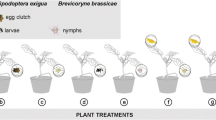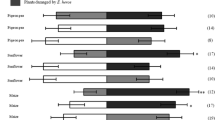Abstract
When an accidentally introduced pest establishes in the invaded area, native natural enemies may adapt to the new host. A decade after the accidental introduction of the brown marmorated stink bug, Halyomorpha halys, in Europe, two generalist native egg parasitoids, the eupelmid Anastatus bifasciatus and the encyrtid Ooencyrtus telenomicida, have been recorded from this invasive agricultural pest in the field. Both species are able to complete development to the adult stage within the new host. Trissolcus basalis (Platygastridae = Scelionidae), which is not associated with H. halys in the field, was reared from freeze-killed sentinel eggs placed on soybean plants in central Italy. We tested in a Y-tube olfactometer the behavioural responses of these egg parasitoids to volatiles from H. halys adults and from Vicia faba plants attacked by H. halys. Both A. bifasciatus and O. telenomicida positively responded to adult H. halys male volatiles and to H. halys-induced plant volatiles, indicating ability to exploit cues associated with the new host for egg location, whereas T. basalis only reacted to female volatiles. A. bifasciatus and O. telenomicida are generalist egg parasitoids, showing a much wider host range when compared to T. basalis. On the other hand, platygastrid egg parasitoids from the native area of H. halys, considered for classical biological control, may be too risky due to the possibility of attacking non-target species, including predaceous stink bugs. Therefore, indigenous A. bifasciatus and O. telenomicida are presently under evaluation for augmentative biological control of H. halys in Europe.



Similar content being viewed by others
References
Abram PK, Gariepy TD, Boivin G, Brodeur J (2014) An invasive stink bug as an evolutionary trap for an indigenous egg parasitoid. Biol Invasions 16:1387–1395
Aldrich JR (1988) Chemical ecology of the Heteroptera. Annu Rev Entomol 33:211–238
Arnold K (2009) Halyomorpha halys (Stål, 1855), a stink bug species newly detected among the European fauna (Insecta: Heteroptera, Pentatomidae, Pentatominae, Cappaeini). Mitt des Thüringer Entomologenverbandes eV 16:10
Biddinger D, Tooker J, Surcica A, Krawczyk G (2012) Survey of native biocontrol agents of the brown marmorated stink bug in Pennsylvania fruit orchards and adjacent habitat. Pa Fruit News 42:47–54
Bin F (1994) Biological control with egg parasitoids other than Trichogramma. In: Wajnberg E, Hassan SA (eds) Biological control with egg parasitoids. CAB International, Oxford, pp 245–271
Colazza S, Peri D, Salerno G, Peri E, Lo Pinto M, Liotta G (1999a) Xbug, a video tracking and motion analysis system for Linux. In: XII International entomophagous insects workshop, Pacific Grove, California
Colazza S, Salerno G, Wajnberg E (1999b) Volatile and contact chemicals released by Nezara viridula (Heteroptera: Pentatomidae) have a kairomonal effect on the egg parasitoid Trissolcus basalis (Hymenoptera: Scelionidae). Biol Control 16:310–317
Colazza S, Fucarino A, Peri E, Salerno G, Conti E, Bin F (2004a) Insect oviposition induces volatile emission in herbaceous plants that attracts egg parasitoids. J Exp Biol 207:47–53
Colazza S, McElfresh JS, Millar JG (2004b) Identification of volatile synomones, induced by Nezara viridula feeding and oviposition on bean spp., that attract the egg parasitoid Trissolcus basalis. J Chem Ecol 30:945–964
Colazza S, Peri E, Salerno G, Conti E (2009) Host searching by egg parasitoids: exploitation of host chemical cues. In: Cônsoli FL, Parra JRP, Zucchi RA (eds) Egg Parasitoids in agroecosystems with emphasis on Trichogramma. Progress in biological control, vol 9. Springer, Netherlands, pp 97–147
Conti E, Colazza S (2012) Chemical ecology of egg parasitoids associated with true bugs. Psyche (Camb Mass) 2012:651015
Conti E, Salerno G, Bin F, Vinson SB (2004) The role of host semiochemicals in parasitoid specificity: a case study with Trissolcus brochymenae and Trissolcus simoni on pentatomid bugs. Biol Control 29:435–444
Conti E et al (2008) Changes in the volatile profile of Brassica oleracea due to feeding and oviposition by Murgantia histrionica (Heteroptera: Pentatomidae). Eur J Entomol 105:839
Cusumano A, Peri E, Amodeo V, McNeil JN, Colazza S (2013) Intraguild interactions between egg parasitoids: window of opportunity and fitness costs for a facultative hyperparasitoid. PLoS One 8:e64768
Fand BB, Suroshe SS, Gautam RD (2013) Fortuitous biological control of insect pests and weeds: a critical review. The Bioscan 8:1–10
Fraga DF, Parker J, Busoli AC, Hamilton GC, Nielsen AL, Rodriguez-Saona C (2016) Behavioral responses of predaceous minute pirate bugs to tridecane, a volatile emitted by the brown marmorated stink bug. J Pest Sci. doi:10.1007/s10340-10016-10825-10349
Gariepy T, Bruin A, Haye T, Milonas P, Vétek G (2015) Occurrence and genetic diversity of new populations of Halyomorpha halys in Europe. J Pest Sci 88:451–460
Harris C, Abubeker S, Yu M, Leskey T, Zhang A (2015) Semiochemical production and laboratory behavior response of the brown marmorated stink bug, Halyomorpha halys. PloS one 10:e0140876
Haye T, Abdallah S, Gariepy T, Wyniger D (2014) Phenology, life table analysis and temperature requirements of the invasive brown marmorated stink bug, Halyomorpha halys, in Europe. J Pest Sci 87:407–418
Haye T, Fischer S, Zhang J, Gariepy T (2015) Can native egg parasitoids adopt the invasive brown marmorated stink bug, Halyomorpha halys (Heteroptera: Pentatomidae), in Europe? J Pest Sci 88:693–705
Herlihy MV, Talamas EJ, Weber DC (2016) Attack and success of native and exotic parasitoids on eggs of Halyomorpha halys in three Maryland habitats. PLoS One 11:e0150275
Hilker M, Meiners T (2010) How do plants “notice” attack by herbivorous arthropods? Biol Rev 85:267–280
Hilker M, Meiners T (2011) Plants and insect eggs: how do they affect each other? Phytochemistry 72:1612–1623
Hoebeke ER, Carter ME (2003) Halyomorpha halys (Stål)(Heteroptera: Pentatomidae): a polyphagous plant pest from Asia newly detected in North America. Proc Entomol Soc Wash 105:225–237
Hoogendoorn M, Heimpel GE (2002) Indirect interactions between an introduced and a native ladybird beetle species mediated by a shared parasitoid. Biol Control 25:224–230
Jones AL, Jennings DE, Hooks CR, Shrewsbury PM (2014) Sentinel eggs underestimate rates of parasitism of the exotic brown marmorated stink bug, Halyomorpha halys. Biol Control 78:61–66
Khrimian A et al (2014) Discovery of the aggregation pheromone of the brown marmorated stink bug (Halyomorpha halys) through the creation of stereoisomeric libraries of 1-bisabolen-3-ols. J Nat Prod 77:1708–1717
Lee D-H, Short BD, Joseph SV, Bergh JC, Leskey TC (2013) Review of the biology, ecology, and management of Halyomorpha halys (Hemiptera: Pentatomidae) in China, Japan, and the Republic of Korea. Environ Entomol 42:627–641
Leskey TC et al (2012a) Pest status of the brown marmorated stink bug, Halyomorpha halys in the USA. Outlooks Pest Manage 23:218–226
Leskey TC, Short BD, Butler BR, Wright SE (2012b) Impact of the invasive brown marmorated stink bug, Halyomorpha halys (Stål), in mid-atlantic tree fruit orchards in the United States: case studies of commercial management. Psyche (Camb Mass) 2012:535062
Maistrello L et al (2014) Primi rinvenimenti in Italia della cimice esotica Halyomorpha halys, una nuova minaccia per la frutticoltura. Atti Giornate Fitopatologiche CLUEB, Bologna, pp 283–288
Maistrello L, Dioli P, Bariselli M, Mazzoli GL, Giacalone-Forini I (2016) Citizen science and early detection of invasive species: phenology of first occurrences of Halyomorpha halys in Southern Europe. Biol Invasions 18:3109–3116
Michereff MFF, Laumann RA, Borges M, Michereff-Filho M, Diniz IR, Neto ALF, Moraes MCB (2011) Volatiles mediating a plant-herbivore-natural enemy interaction in resistant and susceptible soybean cultivars. J Chem Ecol 37:273–285
Moraes MCB, Laumann R, Sujii ER, Pires C, Borges M (2005) Induced volatiles in soybean and pigeon pea plants artificially infested with the neotropical brown stink bug, Euschistus heros, and their effect on the egg parasitoid, Telenomus podisi. Entomol Exp Appl 115:227–237
Moraes MC, Pareja M, Laumann RA, Hoffmann-Campo CB, Borges M (2008) Response of the parasitoid Telenomus podisi to induced volatiles from soybean damaged by stink bug herbivory and oviposition. J Plant Interact 3:111–118
Noyes J (2015) Universal Chalcidoidea Database. http://www.nhmacuk/research-curation/projects/chalcidoids/
Peri E, Cusumano A, Agrò A, Colazza S (2011) Behavioral response of the egg parasitoid Ooencyrtus telenomicida to host-related chemical cues in a tritrophic perspective. Biocontrol 56:163–171
Pinheiro JC, Bates DM (2000) Mixed-effects models in S and S-PLUS. Springer, New York
R Core Team (2014) R: a language and environment for statistical computing. R Foundation for Statistical Computing, Vienna
Rice KB et al (2014) Biology, ecology, and management of brown marmorated stink bug (Hemiptera: Pentatomidae). J Integr Pest Manag 5:A1–A13
Roversi PF, Binazzi F, Marianelli L, Costi E, Maistrello L, Sabbatini Peverieri G (2016) Searching for native egg-parasitoids of the invasive alien species Halyomorpha halys Stal (Heteroptera Pentatomidae) in Southern Europe. Redia 99:63–70
Ruxton GD, Beauchamp G (2008) Time for some a priori thinking about post hoc testing. Behav Ecol 19:690–693
Safavi M (1968) Etude biologique et ecologique des hymenopteres parasites des oeufs des punaises des cereales. Entomophaga 13:381–495
Salerno G, Conti E, Peri E, Colazza S, Bin F (2006) Kairomone involvement in the host specificity of the egg parasitoid Trissolcus basalis (Hymenoptera: Scelionidae). Eur J Entomol 103:311–318
Schlaepfer MA, Sherman PW, Blossey B, Runge MC (2005) Introduced species as evolutionary traps. Ecol Lett 8:241–246
Talamas EJ, Buffington M, Hoelmer K (2013) New synonymy of Trissolcus halyomorphae Yang. J Hymenopt Res 33:113
Talamas EJ, Herlihy MV, Dieckhoff C, Hoelmer KA, Buffington M, Bon M-C, Weber DC (2015) Trissolcus japonicus (Ashmead)(Hymenoptera, Scelionidae) emerges in North America. J Hymenopt Res 43:119
Tognon R, Sant’Ana J, Zhang Q-H, Millar JG, Aldrich JR, Zalom FG (2016) Volatiles Mediating Parasitism of Euschistus conspersus and Halyomorpha halys Eggs by Telenomus podisi and Trissolcus erugatus. J Chem Ecol 42:1016–1027
Van Lenteren JC et al (2003) Environmental risk assessment of exotic natural enemies used in inundative biological control. Biocontrol 48:3–38
Velikova V, Salerno G, Frati F, Peri E, Conti E, Colazza S, Loreto F (2010) Influence of feeding and oviposition by phytophagous pentatomids on photosynthesis of herbaceous plants. J Chem Ecol 36:629–641
Yang Z-Q, Yao Y-X, Qiu L-F, Li Z-X (2009) A new species of Trissolcus (Hymenoptera: Scelionidae) parasitizing eggs of Halyomorpha halys (Heteroptera: Pentatomidae) in China with comments on its biology. Ann Entomol Soc Am 102:39–47
Zhou Y, Giusti MM, Parker J, Salamanca J, Rodriguez-Saona C (2016) Frugivory by brown marmorated stink bug (Hemiptera: Pentatomidae) alters blueberry fruit chemistry and preference by conspecifics. Environ Entomol 45:1227–1234
Zuur AF, Ieno EN, Walker NJ, Saveliev AA, Smith GM (2009) Mixed effects models and extensions in ecology with R. Springer, New York
Acknowledgements
This research was supported by the Marie Skłodowska-Curie Research and Innovation Staff Exchange (RISE) H2020-MSCA-RISE-2015 of the European Union with the project Impact of invasive alien true bug species in native trophic webs – INVASIoN (GA 690952). GR wish to thank Fondazione Cassa di Risparmio di Perugia for funding. The authors are grateful to Andrea Luchetti, Luciana Bartoli, Daniela Fortini and Cesare Dentini for maintaining the stink bug and egg parasitoid cultures and for helping in field collection. The authors also thank Elena Costi (University of Modena and Reggio Emilia) and Giacomo Vaccari (Consorzio Fitosanitario Provinciale di Modena) for field assistance.
Author information
Authors and Affiliations
Corresponding author
Ethics declarations
Conflict of interest
The authors have declared that no conflict of interest exists.
Research involving human participants and/or animals
This article does not contain any studies with human participants or animals (vertebrates) performed by any of the authors.
Informed consent
Informed consent was obtained from all individual participants included in the study.
Additional information
Communicated by M. Traugott.
Special Issue: The brown marmorated stink bug Halyomorpha halys an emerging pest of global concern.
Electronic supplementary material
Below is the link to the electronic supplementary material.
Rights and permissions
About this article
Cite this article
Rondoni, G., Bertoldi, V., Malek, R. et al. Native egg parasitoids recorded from the invasive Halyomorpha halys successfully exploit volatiles emitted by the plant–herbivore complex. J Pest Sci 90, 1087–1095 (2017). https://doi.org/10.1007/s10340-017-0861-0
Received:
Revised:
Accepted:
Published:
Issue Date:
DOI: https://doi.org/10.1007/s10340-017-0861-0




